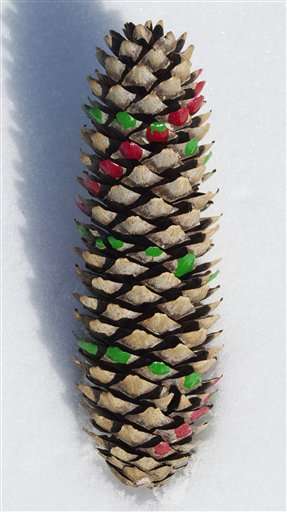Nature follows a number pattern called Fibonacci

What do pine cones and paintings have in common? A 13th century Italian mathematician named Leonardo of Pisa.
Better known by his pen name, Fibonacci, he came up with a number sequence that keeps popping up throughout the plant kingdom, and the art world too.
A fibonacci sequence is simple enough to generate: Starting with the number one, you merely add the previous two numbers in the sequence to generate the next one. So the sequence, early on, is 1, 2, 3, 5, 8, 13, 21 and so on.
Numbers and plants
To see how it works in nature, go outside and find an intact pine cone (or any other cone). Look carefully and you'll notice that the bracts that make up the cone are arranged in a spiral. Actually two spirals, running in opposite directions, with one rising steeply and the other gradually from the cone's base to its tip.
Count the number of spirals in each direction—a job made easier by dabbing the bracts along one line of each spiral with a colored marker. The number of spirals in either direction is a fibonacci number. I just counted 5 parallel spirals going in one direction and 8 parallel spirals going in the opposite direction on a Norway spruce cone.
Or you might examine a pineapple. Focus on one of the hexagonal scales near the fruit's midriff and you can pick out three spirals, each aligned to a different pair of opposing sides of the hexagon. One set rises gradually, another moderately and the third steeply. Count the number of spirals and you'll find eight gradual, 13 moderate and 21 steeply rising ones. Fibonacci numbers again.
Scales and bracts are modified leaves, and the spiral arrangements in pine cones and pineapples reflect the spiral growth habit of stems. To confirm this, bring in a leafless stem from some tree or shrub and look at its buds, where leaves were attached. The buds range up the stem in a spiral pattern, which kept each leaf out of the shadow of leaves just above it. The amount of spiraling varies from plant to plant, with new leaves developing in some fraction—such as 2/5, 3/5, 3/8 or 8/13—of a spiral. Eureka, the numbers in those fractions are fibonacci numbers!
You can determine the fraction on your dormant stem by finding a bud directly above another one, then counting the number of full circles the stem went through to get there while generating buds in between. So if the stems made three full circles to get a bud back where it started and generated eight buds getting there, the fraction is 3/8, with each bud 3/8 of a turn off its neighbor upstairs or downstairs. Different plants have favored fractions, but they evidently don't read the books because I just computed fractions of 1/3 and 3/8 on a single apple stem, which is supposed to have a fraction of 2/5. All are fractions with fibonacci numbers, at least.
Numbers and art
I haven't forgotten about the artists. It turns out there are certain proportions we humans generally find pleasing: the rectangular proportions of a painting, for example, or the placement of a focal point in a painting.
In a painting, for example, the Golden Cut states that the ratio of the distance of the focal point from the closer side to the farther side of a painting is the same as the ratio of the distance from the farther side to the painting's whole width. A pleasing ratio, it turns out, is 0.618... or, if you want to use the inverse, 1.618... . Enter fibonacci: Divide any fibonacci number by the fibonacci number before or after it and you get 0.618... or 1.618..., not exactly at first, but closer and closer the higher the fibonacci number you start with. Try it.
More information: For a good visual explanation of fibonacci in nature, visit allbleedingstops.blogspot.com/ … series-and-pine.html .
For more about basic fibonacci, try the books "Fascinating Fibonaccis: Mystery and Magic in Numbers" and Trudi Hammel Garland's "Fibonacci Fun: Fascinating Activities with Intriguing Numbers" (both from Dale Seymour Publications).
Copyright 2013 The Associated Press. All rights reserved. This material may not be published, broadcast, rewritten or redistributed.





















